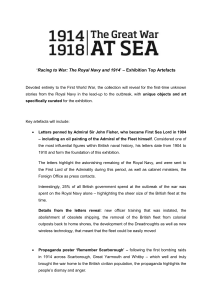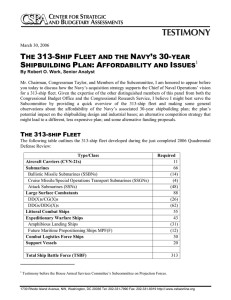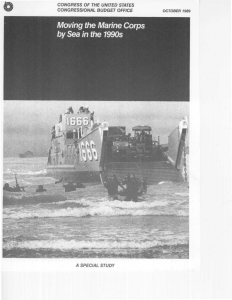POSITION REPORT: 2014
advertisement
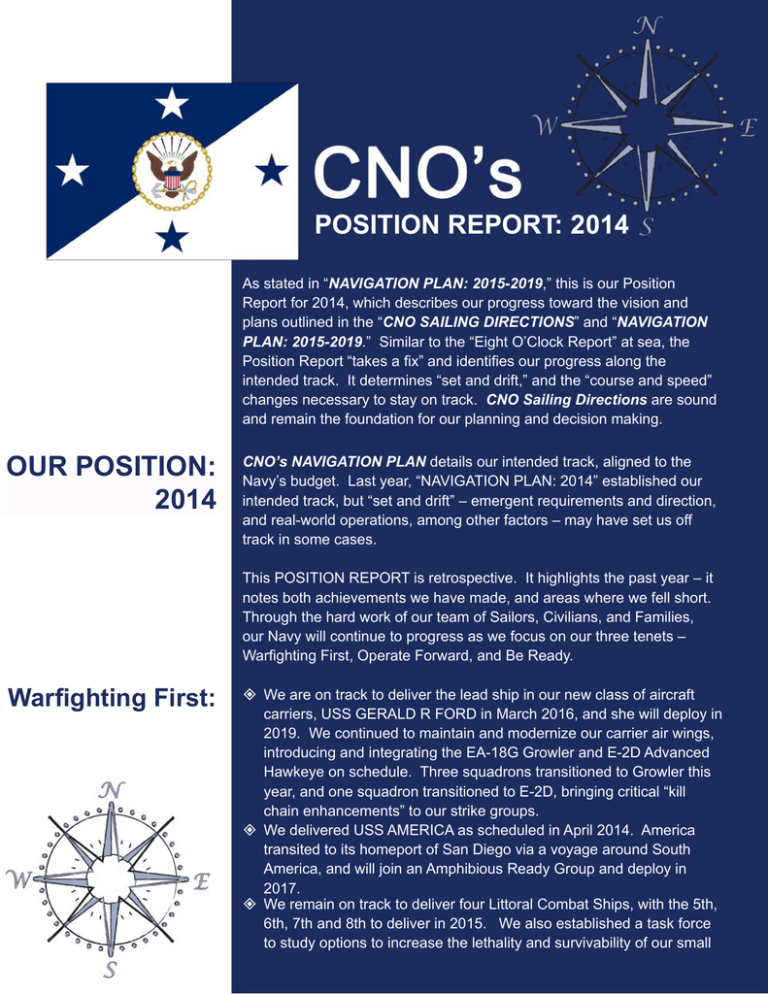
POSITION REPORT: 2014 As stated in “NAVIGATION PLAN: 2015-2019,” this is our Position Report for 2014, which describes our progress toward the vision and plans outlined in the “CNO SAILING DIRECTIONS” and “NAVIGATION PLAN: 2015-2019.” Similar to the “Eight O’Clock Report” at sea, the Position Report “takes a fix” and identifies our progress along the intended track. It determines “set and drift,” and the “course and speed” changes necessary to stay on track. CNO Sailing Directions are sound and remain the foundation for our planning and decision making. OUR POSITION: 2014 CNO’s NAVIGATION PLAN details our intended track, aligned to the Navy’s budget. Last year, “NAVIGATION PLAN: 2014” established our intended track, but “set and drift” – emergent requirements and direction, and real-world operations, among other factors – may have set us off track in some cases. This POSITION REPORT is retrospective. It highlights the past year – it notes both achievements we have made, and areas where we fell short. Through the hard work of our team of Sailors, Civilians, and Families, our Navy will continue to progress as we focus on our three tenets – Warfighting First, Operate Forward, and Be Ready. Warfighting First: We are on track to deliver the lead ship in our new class of aircraft carriers, USS GERALD R FORD in March 2016, and she will deploy in 2019. We continued to maintain and modernize our carrier air wings, introducing and integrating the EA-18G Growler and E-2D Advanced Hawkeye on schedule. Three squadrons transitioned to Growler this year, and one squadron transitioned to E-2D, bringing critical “kill chain enhancements” to our strike groups. We delivered USS AMERICA as scheduled in April 2014. America transited to its homeport of San Diego via a voyage around South America, and will join an Amphibious Ready Group and deploy in 2017. We remain on track to deliver four Littoral Combat Ships, with the 5th, 6th, 7th and 8th to deliver in 2015. We also established a task force to study options to increase the lethality and survivability of our small surface combatants. Their work is complete and we are staffing our proposal through the office of the Secretary of Defense. We maintained our commitment to undersea dominance. As planned, in 2014 we delivered a new Virginia-class attack submarine, USS NORTH DAKOTA, which will be homeported in Groton, CT. We also installed Advanced System Build software and hardware in the Integrated Undersea Surveillance System (IUSS) shore facilities, ensuring their relevance into the future. In the fall of 2014, our largedisplacement unmanned undersea vehicle (LDUUV) program reached its first acquisition gate, Milestone A, which initiated technology development. In electronic warfare, we continued development of the Next Generation Jammer (NGJ), but were compelled to slow delivery due to reduced funding. As a result, it will reach initial operational capability (IOC) in 2021 instead of 2020. Surface Electronic Warfare Improvement Program (SEWIP) Block 2 upgrades were delivered, and installations began on DDG-51 class ships. We expect full-rate production in mid-2015. Our plan to develop a cadre of cyberspace operators remains on track, and will complete by 2016. By that benchmark year, we will have about 1000 new cyber operators manning 12 Cyber Mission Teams, eight Cyber Support Teams, and 20 Cyber Protection Teams. We continued testing the X-47B Unmanned Carrier Aircraft System Demonstrator, and for the first time, we executed simultaneous flight operations with manned and unmanned aircraft in the carrier environment. MQ-8B Fire Scout completed its 10th deployment aboard FFGs. Nineteen larger and longer endurance MQ-8C Fire Scout vehicles are now on contract, and the first MQ-8C deployment aboard LCS will occur in 2015. We continued to advance our plans to relieve stress on our combatants, improve expeditionary warfare, and increase forward presence by employing innovative platforms: o Two Joint High-Speed Vessels (JHSV) were delivered this year, increasing our inventory to four. USNS SPEARHEAD (JHSV 1) completed her maiden deployment to EUCOM, AFRICOM and SOUTHCOM AORs, successfully operating adaptive force packages during those deployments. o Our second Mobile Landing Platform (MLP) was delivered in 2014. We demonstrated MLP’s flexibility and capability with at-sea transfers between USNS MONTFORD POINT (MLP 1), a large, medium speed roll-on, roll-off ship, and a JHSV. Landing craft air-cushion (LCAC) and amphibious assault vehicles (AAV) also launched from MLP 1, demonstrating the ship’s ability to perform as a ship-to-shore connector. We explored expanding the missions of maritime prepositioning ships by employing USMC detachments on a T-AKE in two experiments designed to enhance USN-USMC integration and create more flexible options for theater commanders. The experiments embarked over 100 Marines and Sailors aboard USNS LEWIS AND CLARK for a variety of expeditionary operations in Southeast Asia to test the effectiveness of distributed operations using tailored force packages. We continued deployment of energy efficient technologies across the fleet. We installed hybrid electric propulsion systems to increase surface ship fuel efficiency at low speeds; we equipped T-AKE ships with four intelligent heating, ventilation and air conditioning systems; and, we substituted less efficient lights with over 100,000 solid state (LED) lights on more than 90 surface ships Navy-wide. We saved approximately 12 million gallons of fuel in 2014 while enhancing combat capability through increased platform range and endurance. We completed a final draft of our maritime strategy “A Cooperative Strategy for 21st Century Seapower,” and will publish it by the end of calendar year 2014. We have not published the book “How We Fight” yet, but intend to do so in 2015. Operate Forward: We maintained one Carrier Strike Group (CSG) and one Amphibious Ready Group (ARG) deployed in both the Asia-Pacific and Middle East regions. We continued rebalancing Navy forces to the Asia-Pacific Region. At the end of Fiscal Year 2014, we had 41 ships and submarines based in theater. In 2020, we will have 54 ships and submarines based in theater. We remain on track to add two DDGs to Yokosuka, Japan (one each in 2015 and 2017), one attack submarine to Guam in 2016, two LCS to Singapore in 2016, and two LCS to Singapore in 2017. P-8A Poseidon completed its first operational deployment to the Western Pacific in 2014, on-time and with strong operational results. One squadron completed the transition from P-3C to P-8A in 2014, and we are on track to complete the transition of another two squadrons in 2015. In Europe, we forward based two guided missile destroyers to Rota, Spain, the USS DONALD COOK and USS ROSS, and are on track to forward base two more DDGs in 2015. We began construction of the Aegis Ashore support infrastructure in Romania and opened the Naval Support Activity. It will reach operational status by the end of 2015 as part of the President’s European Phased Adaptive Approach for ballistic missile defense. We forward-deployed four mine countermeasure ships (MCM) and all 10 coastal patrol ships (PC) to Bahrain. We are on track to establish a fifth ARG in the Pacific by 2018. It will be the most advanced and capable ARG in the fleet in that it will contain one amphibious assault ship (LHD/A) and two amphibious dock ships (LPD). Be Ready: We developed the Optimized Fleet Response Plan (O-FRP). By 2016, this new readiness construct will provide more capacity and predictability in maintenance and training, and provide stability for our deploying forces and their families. The EISENHOWER Carrier Strike Group, which deploys in 2016, will be the first CSG to execute one full O-FRP cycle. We incentivized Sea Duty through a 25 percent increase in Career Sea Pay, and increased Career Sea Pay-Premium by $100 per month. To compensate Sailors for longer periods at sea, we also implemented “Hardship Duty Pay-Tempo” (HDP-T). For each day spent underway in excess of 220 days, Sailors are compensated at a daily rate of $16.50, up to $495 per month. Personnel shortfalls directly impacting fleet readiness that had been identified in our fleet Integrated Readiness Assessment, both afloat and ashore, are now being addressed by the Chief of Naval Personnel and fleet actions: o We increased Naval Shipyard end strength by 1,500 to expand capacity for carrier and submarine depot maintenance and reduce backlogs. Also, we invested $160M in military construction and repair projects to improve the condition of our shipyard infrastructure. o Regional Maintenance Centers and Afloat Training Groups increased end strength by 1,400 billets, and have filled roughly 700. Hiring will continue in 2015. We improved fleet manning by filling approximately 3,500 gapped billets last year; the fleet’s at-sea billets are now 96 percent manned (fill). This exceeds our goal of 95 percent for 2014. We established the 21st Century Sailor Office, embarked on a comprehensive communication plan to engage the fleet, and expanded resiliency programs: o Death by suicide continues to be a concern for Sailors, their Family and friends, and the Navy. To help Sailors learn how to better deal with stress, we have deployed Operational Sress Control Mobile Training Teams around the fleet. We increased Operational Stress Control Mobile Training Teams by 50 percent to provide pre-deployment training; o 16 of 21 planned Deployed Resiliency Counselors have been hired, one for each aircraft carrier and large deck amphibious ship. We will complete hiring in 2015; o 16 Echelon II/III sexual assault, prevention, and response (SAPR) officers and Regional SAPR officers have been trained to support fleet leadership and increase the capacity, expertise, and effectiveness in prevention and response; o We implemented an awareness campaign and created peer-delivered bystander intervention skills training that will be delivered in the fleet in 2015 to help Sailors identify and prevent destructive behaviors. o Instances of wrongful prescription drug use have climbed, thus we added testing for synthetic drugs and expanded the detection capability of prescription drugs in our urinalysis program. o A “Transition Goals, Plans, Success” curriculum for separating Sailors has been implemented. Formerly known as the Transition Assistance Program (TAP), this more in-depth curriculum provides Sailors professional development resources throughout their careers, and helps ensure transition to a successful civilian career. To improve combat readiness at sea, we also delivered 111 high speed surface targets (small craft), which are used to enhance the realism of fleet training events involving “swarm tactics.” To provide continued training against air threats to our surface forces, we awarded a contract for a new Aerial Target Operations Facility at Dam Neck, VA. When it opens in 2017, it will consolidate all aerial target operations into a single facility, and provide an increased capability to operate three different types of aerial targets. We conducted several major combined, joint, and fleet exercises including Rim of the Pacific 2014, Bold Alligator, and Valiant Shield. Finally, we hosted representatives from 113 countries, including 75 heads of navy and 21 heads of coast guard, at the International Seapower Symposium in Newport, Rhode Island, to build trust and promote cooperation on a wide variety of shared maritime challenges. Our superb Sailors, Civilians, and their Families have enabled the Navy to remain ready, forward, and engaged in challenging times. With their continued commitment, we will remain the most powerful and influential maritime force on the planet. Please continue to provide your feedback as we navigate into our future.
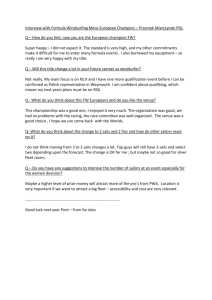


![[STORY ARCHIVES IMAGE]](http://s3.studylib.net/store/data/007416224_1-64c2a7011f134ef436c8487d1d0c1ae2-300x300.png)

